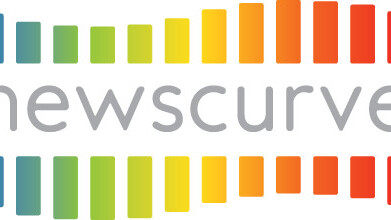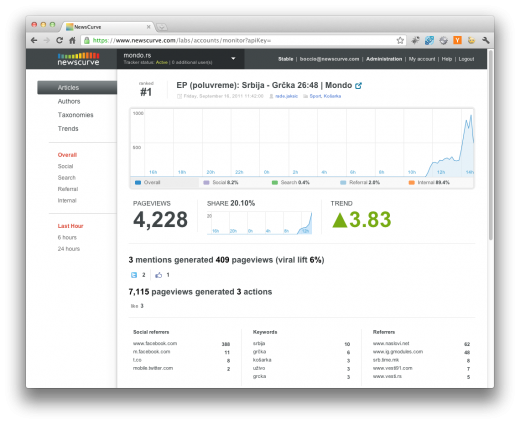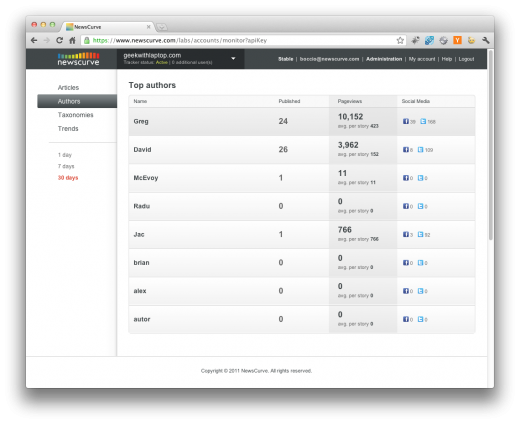
“To get publishers and editors so addicted to it, they scream in sheer horror if the system goes down for even just 10 minutes.”
That is the mission of NewsCurve, a new elegantly designed analytics web app that I’ve personally put to the test of over the last two weeks, and “addicted” I am.
What is it?
NewsCurve provides the tools necessary for publishers to measure and increase performance of their publication by discovering key insights into which content, topics, and authors generate interest.
There are fundamentally three parts of your site that Newscurve lets you track and measure: content, topics and authors. The goal being to make it as easy as possible for editors to identify and promote content, topics and authors that generate the highest level of engagement as and when they choose.
NewsCurve aims to take the guess work out of editing a modern day news site or blog. If you find yourself asking questions such as: Do I keep this article on the front page a little longer? Does this type of content do particularly well on our site? Is this article getting enough attention? Are people engaging more with stories written by author James than with stories from author Janes? Should I share it again to give it more attention? Newscurve is worth trying now.
NewsCurve isn’t a Google Analytics replacement, it isn’t intended to be. It’s intended to complement the behemoths that are Google Analytics and Clicky and provide a real time content, publisher and editor focused solution to help you decide what and who is killing it (in a good way or a bad way) on your site.
NewsCurve prides itself on providing ways for editors to recognise failure quickly, success quickly and react as quick as possible.
Features
While not intended as a full featured analytics solution, it’s likely you’ll find yourself spending more time using NewsCurve than your standard analytics offering. Why? Well if you’re an editor, it’s content, who’s writing the content and who’s reading it that matters most. NewsCurve has been built from the ground up to serve you and while it’s still early days, Newscurve has the potential to be a ground breaking solution for the plethora of news sites, online magazines and blogs out there who want to know more than just what pages are being read, how much traffic is being generated and who’s sending it.
With limited time, it’s difficult to delve too deeply into NewsCurve’s plethora of features but I’ll attempt to give you a solid overview of each.
Articles
Article analytics on NewsCurve give you a near real time look at how content is performing on your site. You can dig into specific articles or just retrieve a general overview of: what’s doing well, what’s not doing too well, what’s gaining interest, what’s losing interest, what article has the most retweets, what articles have the most Facebook likes, what articles have been voted up on Reddit, what articles have the most comments and so on.
NewsCurve also provides a simple way to see precisely where your traffic is sourced from over periods up to 24 hours. We’re talking: social, search, referrals or internal and specific domains too. The referral details still have a lot to be desired but do give enough of an overview about where your traffic is sources from.
Authors
This section I recommend you be selective over who you give access to, it might just give your authors a heart attack.
This is NewsCurve’s golden nugget, although there is one direct competitor to NewsCurve publicly launching soon, I can confidently say now that NewsCurve is first to this feature and for many editors, myself included, it’s priceless.
The authors section of NewsCurve provides an overview of how the authors on your site have been performing over the last day, 7 days or 30 days. This is essentially a table with a number of columns each giving you an indication of how many articles that author has written, how many page views generated, what’s the average number of page views per article, how many facebook likes, twitter mentions they earned and more. An editor’s dream, an authors nightmare. Unfortunately Newscurve doesn’t currently have the permission set to only give this section of its web app to certain users, but you can expect that in time.
Taxonomies
Taxonomies are essentially sections of your site, topics if you will. Currently a rather underdeveloped part of NewsCurve, it’s intended as an overview of the topics that are currently thriving on your site and the topics that aren’t.
Should you try it?
While NewsCurve is still in beta, you can sign up now, and there’s absolutely no question NewsCurve would immediately be of tremendous asset on any publisher’s website – although it’s naturally going to be of more use to those with a team of writers and regular content.
As useful as it is today, there’s a mountain of features I’m looking forward to seeing integrated and I’m certain once you begin using it, you’ll find yourself dreaming up your own concoction of dream features too. Fortunately the team behind the start up, headquartered in Serbia, are as responsive to ideas as they come whilst remaining true to their mission – editor addiction.
Prices vary between free for a site with less than 100,000 pageviews a month, through to $249 for up to 10 websites up to 25 million pageviews a month. Each plan comes with a free 30 day trial period.
Get the TNW newsletter
Get the most important tech news in your inbox each week.





